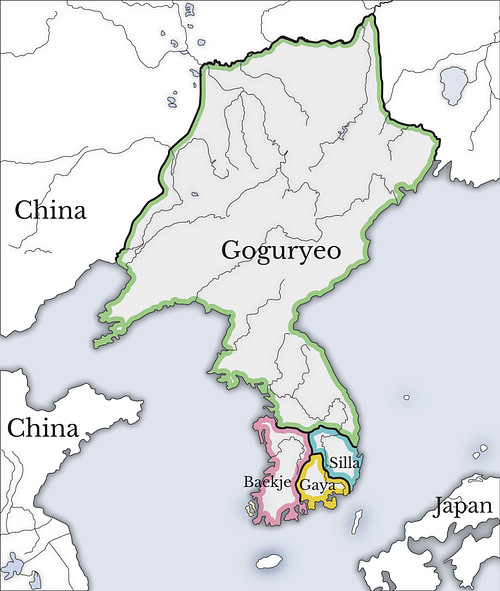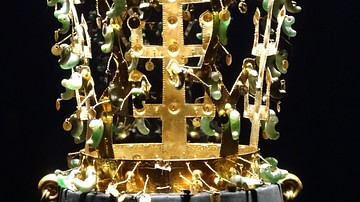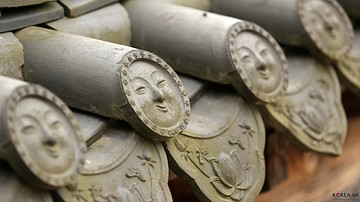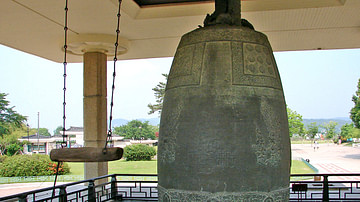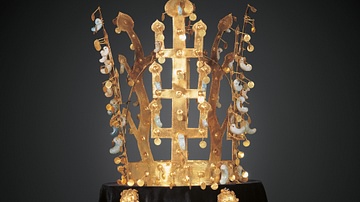
Queen Seondeok (Sondok) ruled the ancient kingdom of Silla from 632 to 647 CE and was the first female sovereign in ancient Korea. Silla was on the verge of dominating the whole of the Korean peninsula and Seondeok helped progress her kingdom towards this goal. Her reign was also distinguished by the increased integration of Buddhism, already the official state religion, and the construction of the famous Cheomseongdae, the oldest observatory in East Asia.
Accession
Seondeok gained the throne because her father, king Jinpyeong (Chinpyong, r. 579-632 CE) who had reigned for 53 years, had no male heir. The fact that a queen could rule alone is testimony to the traditional high status of women in the royal lineage and illustrates the rigidity of the Silla social class system. The latter was based on the bone rank system which dictated all manner of privileges and obligations based on one's birth and bloodline. The highest social level was the sacred bone class which was only held by members of the royal house of Kim. When Jinpyeong died there were no living males of sacred bone rank and so one of two things had to happen: either the whole social class system had to be restructured or a queen was permitted to rule. The latter choice was taken, as it was again for the same reasons for Seondeok's successor.
Seondeok was her father's eldest daughter and her accession was recognised by the Tang Dynasty in 635 CE. In such historical records as the 12th-century CE Samguk sagi ('History of the Three Kingdoms'), she is referred to as wang (king) like her male predecessors. Seondeok was the kingdom's 27th ruler and inherited a prospering state with Silla, in the south-east of the Korean peninsula on the verge of conquering her long-time rivals of the Three Kingdoms period - Baekje (Paekche) to the west and Goguryeo (Koguryo) to the north. According to the Samguk sagi, one of the first acts of Seondeok as queen was to establish aid for poor commoners in the countryside.
The Two Kims
Seondeok benefitted from having at her disposal the talents of the famous general Kim Yu-sin (595-673) and her nephew, the gifted diplomat Gim Chun-chu (aka Kim Chunchu, d. 661 CE). Chun-chu was sent on a diplomatic mission to King Bojang of Goguryeo in 641 CE for help against an ever-more aggressive Baekje. The Goguryeo king, though, would only help if Silla gave up some of the territory they had previously taken from his kingdom. Seondeok refused, and so Chun-chu was imprisoned. The queen then dispatched a 10,000-man army led by Kim Yu-sin to rescue Chun-chu and rebuke Bojang for his impudence. When the Goguryeo monarch discovered an army was on its way he promptly released his captive. Both Kims would go on to greatly help Silla unify Korea and so win the legendary status they still enjoy in Korea today.
Relations with Tang China
Seondeok's immediate neighbours were still powerful and they continued to harass Silla (especially Baekje) to the extent that in 643 CE the queen sent a diplomatic embassy to China to persuade them to help meet this threat. The Chinese Tang Dynasty (618-907 CE) saw an opportunity to play these troublesome southern kingdoms against each other for their own benefit and so were happy to create an alliance with one of them so as to better deal with the remaining two.
Silla and China had long been trading partners and cultural exchange had seen the adoption of Tang court customs and Silla students and scholars being sent to China for study. Queen Seondeok strengthened these ties still further, but the Tangs would not give aid for nothing. Despite the emperor Taizong generously offering an army and even several thousand uniforms and Tang army banners so that Silla soldiers could better intimidate their enemies, there was one catch. The queen would have to stand down and allow a Chinese prince to rule Silla with the Tang emperor's justification for this necessity being his belief that a female ruler was emboldening Silla's enemies. Naturally, Seondeok diplomatically refused this condition but managed to gain Tang military assistance anyway, and the two states formed a joint army to quash Baekje and Goguryeo. However, the plan of action was unsuccessful, and they were soundly beaten by a Goguryeo force led by the celebrated general Yang Manchun in 644 CE. Three more times Tang armies were defeated over the following decade, and Silla would have to wait until 660 CE when another joint Tang-Silla force, this time considerably bigger than previous invasions, was formed and Baekje (660 CE) and Goguryeo (668 CE) were finally crushed.
A Thriving Kingdom
At home Seondeok's domestic policies were more successful than her foreign policy, and Silla saw a flourishing of the arts and sciences. The state became more centralised, and Buddhism was further encouraged, especially as it enhanced the aura of power enjoyed by Silla's ruling class and endorsed the monarch as an incarnation of the Buddha. No surprise then, that the queen also oversaw an extensive rebuilding programme, especially of Buddhist temples. Unfortunately, temples were largely made of wood and so have not survived, but some of their stone pagodas still stand. Schools were another area of investment by the queen during her reign.
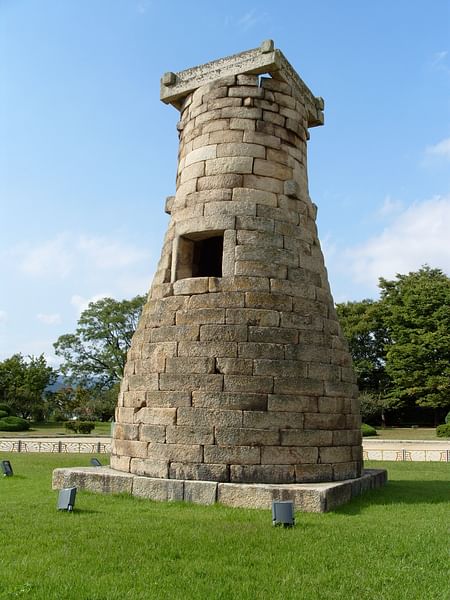
A notable surviving structure from Queen Seondeok's reign is the Cheomseongdae observatory at Gyeongju, the Silla capital. Nine metres tall, it acted like a sundial but also has a south-facing window which captures the sun's rays on the interior floor on each equinox. It was probably part of a larger complex dedicated to science and astronomy in particular. It is the oldest surviving observatory in East Asia. The tower has 27 brick courses representing Seondeok as the 27th Silla ruler. Some historians, without much support in terms of evidence or wider scholarly consensus, go further and suggest that the bottle shape of the structure is either itself a representation of Seondeok and the feminine form or a temple dedicated to her worship.
Hwangnyongsa Temple
Another important building project completed during Queen Seondeok's reign was the Buddhist temple at Hwangnyongsa ('Temple of the illustrious Dragon') in Gyeongju. The project was actually begun in the reign of King Jinheung, around 553 CE, on the spot where a yellow dragon was said to have appeared promising that Silla would destroy all its enemies.
The square temple site measured some 280 x 280 metres and contained a huge statue of the Buddha, possibly as high as 4 metres. Under Queen Seondeok, an imposing nine-story wooden pagoda was added to the temple site, its construction supervised by the monk and Chief Abbot of the State, Jajang (aka Chajang, 590-658 CE) and built by the master architect Abiji from Baekje. Completed in 645 CE, the pagoda perhaps reached a height of 68-70 metres, which made it one of the tallest buildings in East Asia at the time. The nine levels of the building represented the nine other East Asian nations which, it was believed, Silla would eventually conquer, including Japan and China.
A massive bell, said to have weighed (an improbable) 300 tons and been 3 metres high, was cast and added to the temple in 754 CE but it has not survived. The Hwangnyongsa temple was, unfortunately, destroyed by the Mongols in 1238 CE but the foundations and several statue bases remain today to help modern visitors visualise its lost grandeur.
Death & Successors
Seondeok died during a rebellion by disgruntled elements of the Silla aristocracy led by Kim Bidam, chairman of the government council of nobles. These aristocrats, who had the backing of the Tang dynasty, did not agree that a queen should sit on the throne of Silla, and believed that monarchs should now be chosen from members outside the sacred bone class, that is, themselves. The attempt to take her throne was quashed by the lower aristocracy who were led by the two Kims, but Queen Seondeok died, in any case, probably of illness. The queen was entombed within the sacred mountain of Nangsan, Gyeongju.
Seondeok was succeeded by another queen, Jindeok (r. 647-654 CE), who followed in her cousin's footsteps and helped Silla dominate the Korean peninsula. Once again there had been no Gim/Kim male of sacred bone rank, and after two queens, the bone rank system was modified with the highest sacred bone rank abolished and monarchs now chosen from the wider second level, the true bone rank. The next monarch after Jindeok would be none other than Gim Chun-chu, now calling himself King Muyeol, the first Silla monarch not to have been a member of the true bone rank and whose son would finally create the Unified Silla Kingdom ruling all of the Korean peninsula from 668 CE.
This content was made possible with generous support from the British Korean Society.
